Strategic Management Report: Aston Martin Strategy Analysis, UK
VerifiedAdded on 2023/01/19
|10
|3049
|82
Report
AI Summary
This report provides a comprehensive analysis of strategic management, focusing on the case of Aston Martin, a UK-based sports car manufacturer. The report begins by defining strategic management and outlining the process organizations use to determine their strategies, including clarifying vision, gathering information, formulating, implementing, and evaluating strategies. It then evaluates critical models and tools, specifically PESTLE and SWOT analyses, explaining their components and application in assessing the external and internal business environments. The report applies these tools to Aston Martin, providing a detailed PESTLE and SWOT analysis of the company. Finally, the report critically appraises the importance of change management, considering its complexity, cost, risk, and sustainability within the context of organizational transformation. The report concludes with a summary of key findings and insights into strategic decision-making and its implications for Aston Martin's future.
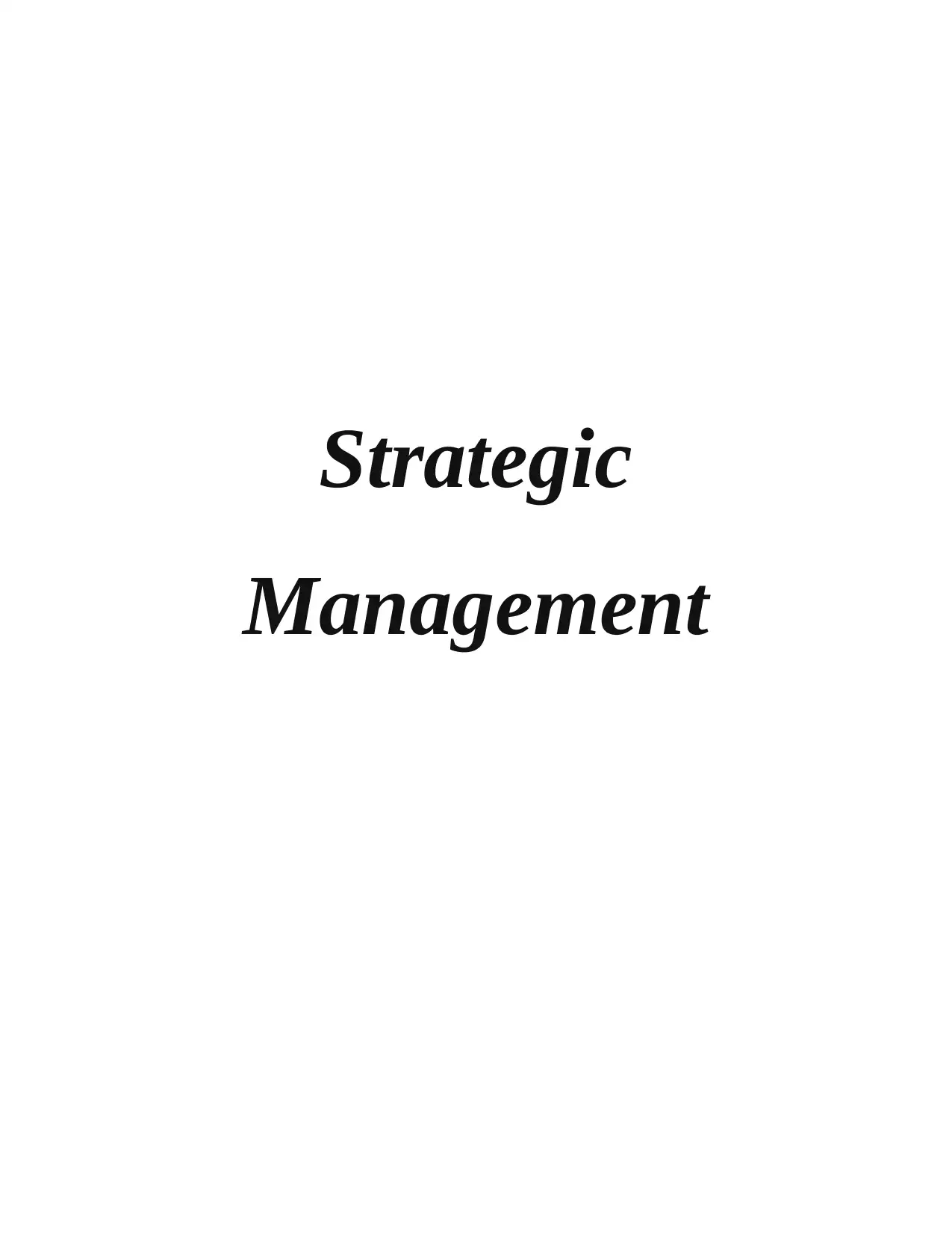
Strategic
Management
Management
Paraphrase This Document
Need a fresh take? Get an instant paraphrase of this document with our AI Paraphraser
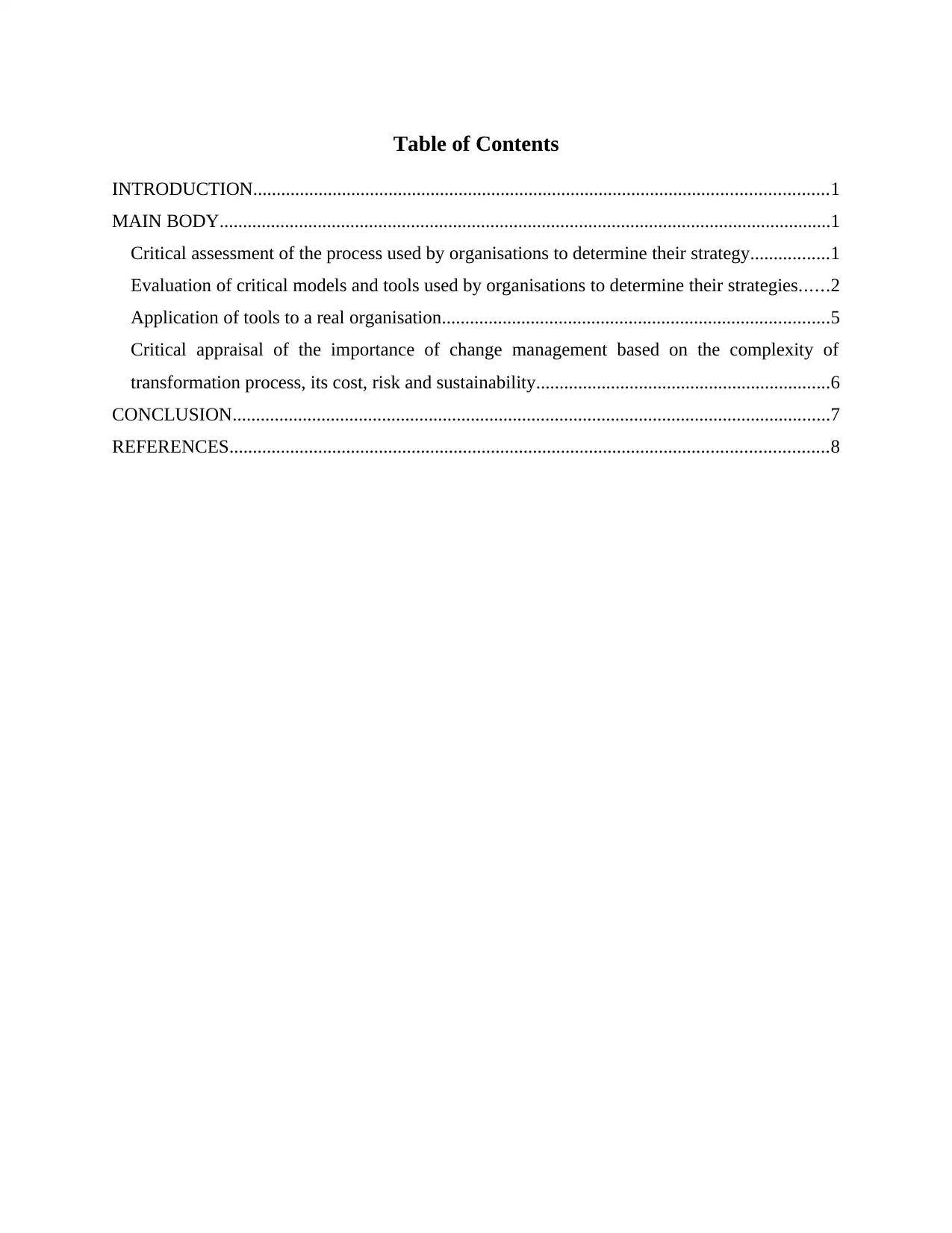
Table of Contents
INTRODUCTION...........................................................................................................................1
MAIN BODY...................................................................................................................................1
Critical assessment of the process used by organisations to determine their strategy.................1
Evaluation of critical models and tools used by organisations to determine their strategies......2
Application of tools to a real organisation...................................................................................5
Critical appraisal of the importance of change management based on the complexity of
transformation process, its cost, risk and sustainability...............................................................6
CONCLUSION................................................................................................................................7
REFERENCES................................................................................................................................8
INTRODUCTION...........................................................................................................................1
MAIN BODY...................................................................................................................................1
Critical assessment of the process used by organisations to determine their strategy.................1
Evaluation of critical models and tools used by organisations to determine their strategies......2
Application of tools to a real organisation...................................................................................5
Critical appraisal of the importance of change management based on the complexity of
transformation process, its cost, risk and sustainability...............................................................6
CONCLUSION................................................................................................................................7
REFERENCES................................................................................................................................8
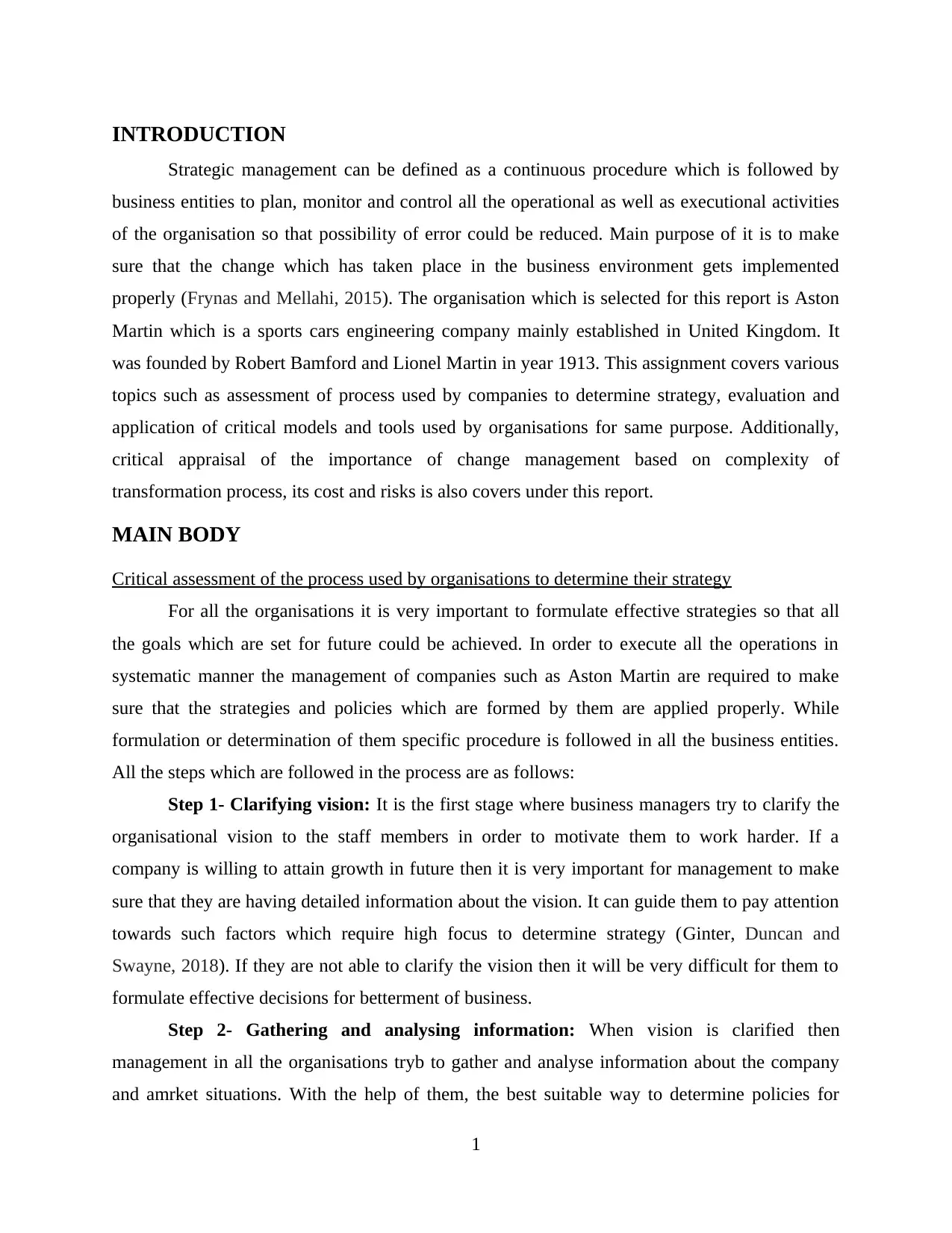
INTRODUCTION
Strategic management can be defined as a continuous procedure which is followed by
business entities to plan, monitor and control all the operational as well as executional activities
of the organisation so that possibility of error could be reduced. Main purpose of it is to make
sure that the change which has taken place in the business environment gets implemented
properly (Frynas and Mellahi, 2015). The organisation which is selected for this report is Aston
Martin which is a sports cars engineering company mainly established in United Kingdom. It
was founded by Robert Bamford and Lionel Martin in year 1913. This assignment covers various
topics such as assessment of process used by companies to determine strategy, evaluation and
application of critical models and tools used by organisations for same purpose. Additionally,
critical appraisal of the importance of change management based on complexity of
transformation process, its cost and risks is also covers under this report.
MAIN BODY
Critical assessment of the process used by organisations to determine their strategy
For all the organisations it is very important to formulate effective strategies so that all
the goals which are set for future could be achieved. In order to execute all the operations in
systematic manner the management of companies such as Aston Martin are required to make
sure that the strategies and policies which are formed by them are applied properly. While
formulation or determination of them specific procedure is followed in all the business entities.
All the steps which are followed in the process are as follows:
Step 1- Clarifying vision: It is the first stage where business managers try to clarify the
organisational vision to the staff members in order to motivate them to work harder. If a
company is willing to attain growth in future then it is very important for management to make
sure that they are having detailed information about the vision. It can guide them to pay attention
towards such factors which require high focus to determine strategy (Ginter, Duncan and
Swayne, 2018). If they are not able to clarify the vision then it will be very difficult for them to
formulate effective decisions for betterment of business.
Step 2- Gathering and analysing information: When vision is clarified then
management in all the organisations tryb to gather and analyse information about the company
and amrket situations. With the help of them, the best suitable way to determine policies for
1
Strategic management can be defined as a continuous procedure which is followed by
business entities to plan, monitor and control all the operational as well as executional activities
of the organisation so that possibility of error could be reduced. Main purpose of it is to make
sure that the change which has taken place in the business environment gets implemented
properly (Frynas and Mellahi, 2015). The organisation which is selected for this report is Aston
Martin which is a sports cars engineering company mainly established in United Kingdom. It
was founded by Robert Bamford and Lionel Martin in year 1913. This assignment covers various
topics such as assessment of process used by companies to determine strategy, evaluation and
application of critical models and tools used by organisations for same purpose. Additionally,
critical appraisal of the importance of change management based on complexity of
transformation process, its cost and risks is also covers under this report.
MAIN BODY
Critical assessment of the process used by organisations to determine their strategy
For all the organisations it is very important to formulate effective strategies so that all
the goals which are set for future could be achieved. In order to execute all the operations in
systematic manner the management of companies such as Aston Martin are required to make
sure that the strategies and policies which are formed by them are applied properly. While
formulation or determination of them specific procedure is followed in all the business entities.
All the steps which are followed in the process are as follows:
Step 1- Clarifying vision: It is the first stage where business managers try to clarify the
organisational vision to the staff members in order to motivate them to work harder. If a
company is willing to attain growth in future then it is very important for management to make
sure that they are having detailed information about the vision. It can guide them to pay attention
towards such factors which require high focus to determine strategy (Ginter, Duncan and
Swayne, 2018). If they are not able to clarify the vision then it will be very difficult for them to
formulate effective decisions for betterment of business.
Step 2- Gathering and analysing information: When vision is clarified then
management in all the organisations tryb to gather and analyse information about the company
and amrket situations. With the help of them, the best suitable way to determine policies for
1
⊘ This is a preview!⊘
Do you want full access?
Subscribe today to unlock all pages.

Trusted by 1+ million students worldwide
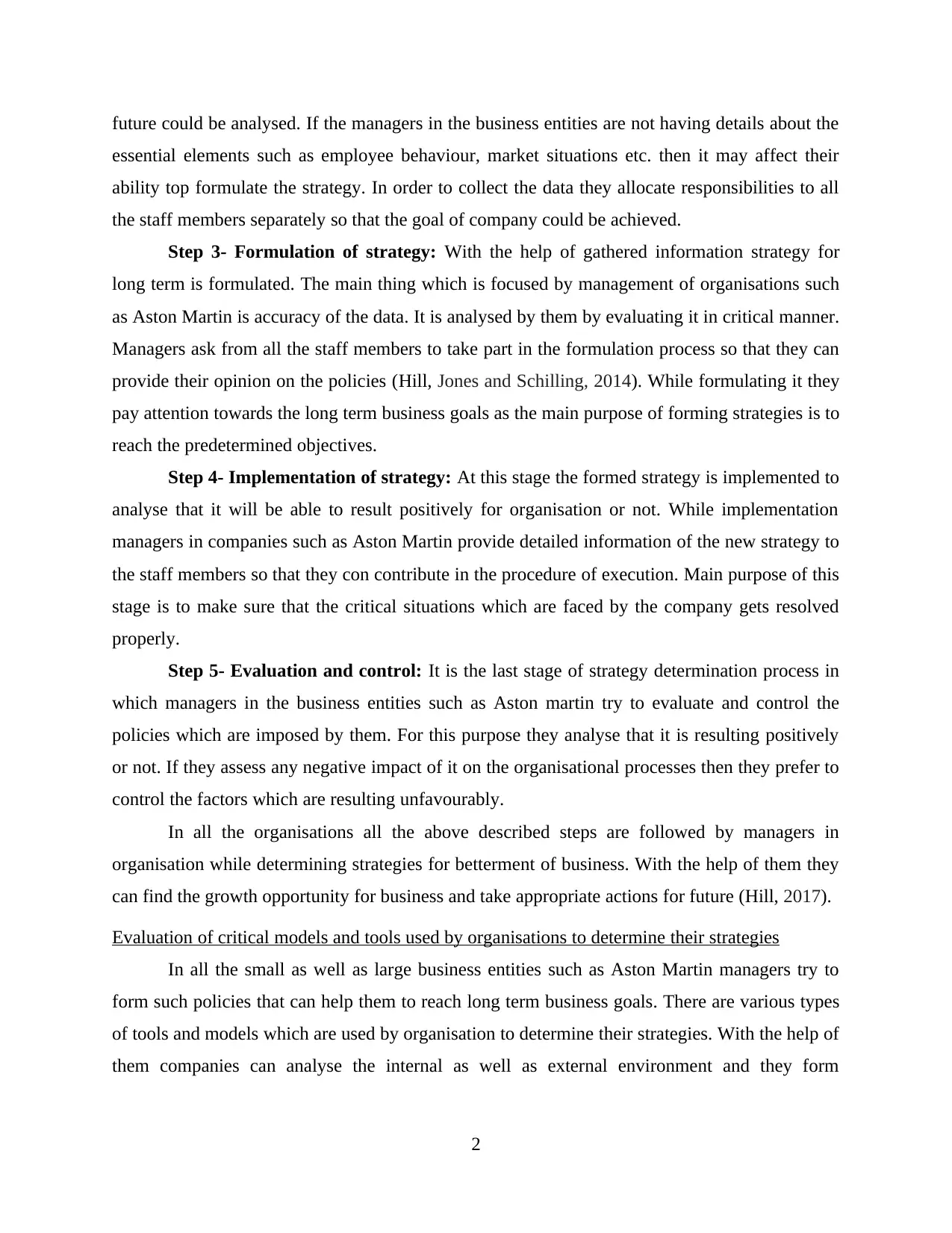
future could be analysed. If the managers in the business entities are not having details about the
essential elements such as employee behaviour, market situations etc. then it may affect their
ability top formulate the strategy. In order to collect the data they allocate responsibilities to all
the staff members separately so that the goal of company could be achieved.
Step 3- Formulation of strategy: With the help of gathered information strategy for
long term is formulated. The main thing which is focused by management of organisations such
as Aston Martin is accuracy of the data. It is analysed by them by evaluating it in critical manner.
Managers ask from all the staff members to take part in the formulation process so that they can
provide their opinion on the policies (Hill, Jones and Schilling, 2014). While formulating it they
pay attention towards the long term business goals as the main purpose of forming strategies is to
reach the predetermined objectives.
Step 4- Implementation of strategy: At this stage the formed strategy is implemented to
analyse that it will be able to result positively for organisation or not. While implementation
managers in companies such as Aston Martin provide detailed information of the new strategy to
the staff members so that they con contribute in the procedure of execution. Main purpose of this
stage is to make sure that the critical situations which are faced by the company gets resolved
properly.
Step 5- Evaluation and control: It is the last stage of strategy determination process in
which managers in the business entities such as Aston martin try to evaluate and control the
policies which are imposed by them. For this purpose they analyse that it is resulting positively
or not. If they assess any negative impact of it on the organisational processes then they prefer to
control the factors which are resulting unfavourably.
In all the organisations all the above described steps are followed by managers in
organisation while determining strategies for betterment of business. With the help of them they
can find the growth opportunity for business and take appropriate actions for future (Hill, 2017).
Evaluation of critical models and tools used by organisations to determine their strategies
In all the small as well as large business entities such as Aston Martin managers try to
form such policies that can help them to reach long term business goals. There are various types
of tools and models which are used by organisation to determine their strategies. With the help of
them companies can analyse the internal as well as external environment and they form
2
essential elements such as employee behaviour, market situations etc. then it may affect their
ability top formulate the strategy. In order to collect the data they allocate responsibilities to all
the staff members separately so that the goal of company could be achieved.
Step 3- Formulation of strategy: With the help of gathered information strategy for
long term is formulated. The main thing which is focused by management of organisations such
as Aston Martin is accuracy of the data. It is analysed by them by evaluating it in critical manner.
Managers ask from all the staff members to take part in the formulation process so that they can
provide their opinion on the policies (Hill, Jones and Schilling, 2014). While formulating it they
pay attention towards the long term business goals as the main purpose of forming strategies is to
reach the predetermined objectives.
Step 4- Implementation of strategy: At this stage the formed strategy is implemented to
analyse that it will be able to result positively for organisation or not. While implementation
managers in companies such as Aston Martin provide detailed information of the new strategy to
the staff members so that they con contribute in the procedure of execution. Main purpose of this
stage is to make sure that the critical situations which are faced by the company gets resolved
properly.
Step 5- Evaluation and control: It is the last stage of strategy determination process in
which managers in the business entities such as Aston martin try to evaluate and control the
policies which are imposed by them. For this purpose they analyse that it is resulting positively
or not. If they assess any negative impact of it on the organisational processes then they prefer to
control the factors which are resulting unfavourably.
In all the organisations all the above described steps are followed by managers in
organisation while determining strategies for betterment of business. With the help of them they
can find the growth opportunity for business and take appropriate actions for future (Hill, 2017).
Evaluation of critical models and tools used by organisations to determine their strategies
In all the small as well as large business entities such as Aston Martin managers try to
form such policies that can help them to reach long term business goals. There are various types
of tools and models which are used by organisation to determine their strategies. With the help of
them companies can analyse the internal as well as external environment and they form
2
Paraphrase This Document
Need a fresh take? Get an instant paraphrase of this document with our AI Paraphraser
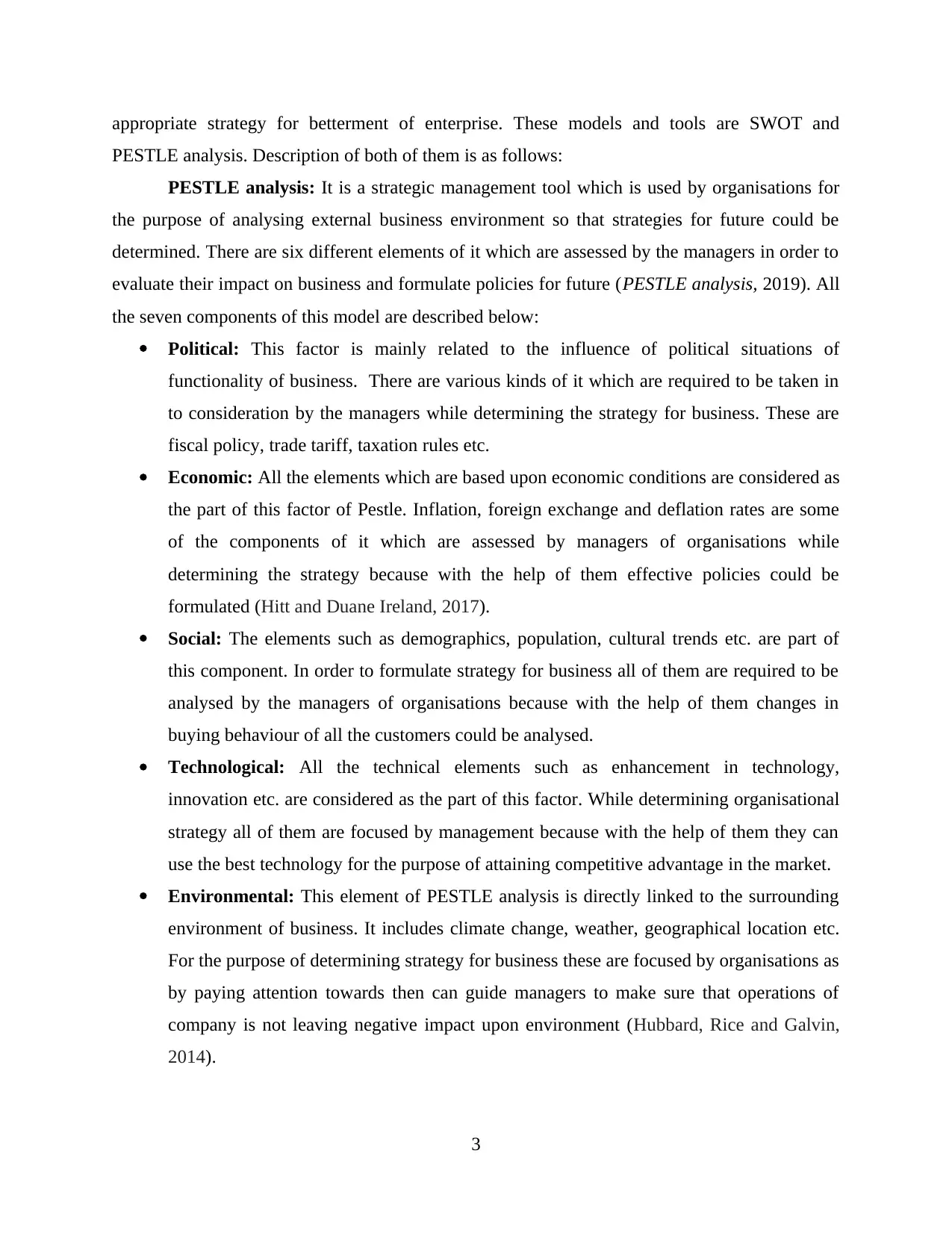
appropriate strategy for betterment of enterprise. These models and tools are SWOT and
PESTLE analysis. Description of both of them is as follows:
PESTLE analysis: It is a strategic management tool which is used by organisations for
the purpose of analysing external business environment so that strategies for future could be
determined. There are six different elements of it which are assessed by the managers in order to
evaluate their impact on business and formulate policies for future (PESTLE analysis, 2019). All
the seven components of this model are described below:
Political: This factor is mainly related to the influence of political situations of
functionality of business. There are various kinds of it which are required to be taken in
to consideration by the managers while determining the strategy for business. These are
fiscal policy, trade tariff, taxation rules etc.
Economic: All the elements which are based upon economic conditions are considered as
the part of this factor of Pestle. Inflation, foreign exchange and deflation rates are some
of the components of it which are assessed by managers of organisations while
determining the strategy because with the help of them effective policies could be
formulated (Hitt and Duane Ireland, 2017).
Social: The elements such as demographics, population, cultural trends etc. are part of
this component. In order to formulate strategy for business all of them are required to be
analysed by the managers of organisations because with the help of them changes in
buying behaviour of all the customers could be analysed.
Technological: All the technical elements such as enhancement in technology,
innovation etc. are considered as the part of this factor. While determining organisational
strategy all of them are focused by management because with the help of them they can
use the best technology for the purpose of attaining competitive advantage in the market.
Environmental: This element of PESTLE analysis is directly linked to the surrounding
environment of business. It includes climate change, weather, geographical location etc.
For the purpose of determining strategy for business these are focused by organisations as
by paying attention towards then can guide managers to make sure that operations of
company is not leaving negative impact upon environment (Hubbard, Rice and Galvin,
2014).
3
PESTLE analysis. Description of both of them is as follows:
PESTLE analysis: It is a strategic management tool which is used by organisations for
the purpose of analysing external business environment so that strategies for future could be
determined. There are six different elements of it which are assessed by the managers in order to
evaluate their impact on business and formulate policies for future (PESTLE analysis, 2019). All
the seven components of this model are described below:
Political: This factor is mainly related to the influence of political situations of
functionality of business. There are various kinds of it which are required to be taken in
to consideration by the managers while determining the strategy for business. These are
fiscal policy, trade tariff, taxation rules etc.
Economic: All the elements which are based upon economic conditions are considered as
the part of this factor of Pestle. Inflation, foreign exchange and deflation rates are some
of the components of it which are assessed by managers of organisations while
determining the strategy because with the help of them effective policies could be
formulated (Hitt and Duane Ireland, 2017).
Social: The elements such as demographics, population, cultural trends etc. are part of
this component. In order to formulate strategy for business all of them are required to be
analysed by the managers of organisations because with the help of them changes in
buying behaviour of all the customers could be analysed.
Technological: All the technical elements such as enhancement in technology,
innovation etc. are considered as the part of this factor. While determining organisational
strategy all of them are focused by management because with the help of them they can
use the best technology for the purpose of attaining competitive advantage in the market.
Environmental: This element of PESTLE analysis is directly linked to the surrounding
environment of business. It includes climate change, weather, geographical location etc.
For the purpose of determining strategy for business these are focused by organisations as
by paying attention towards then can guide managers to make sure that operations of
company is not leaving negative impact upon environment (Hubbard, Rice and Galvin,
2014).
3
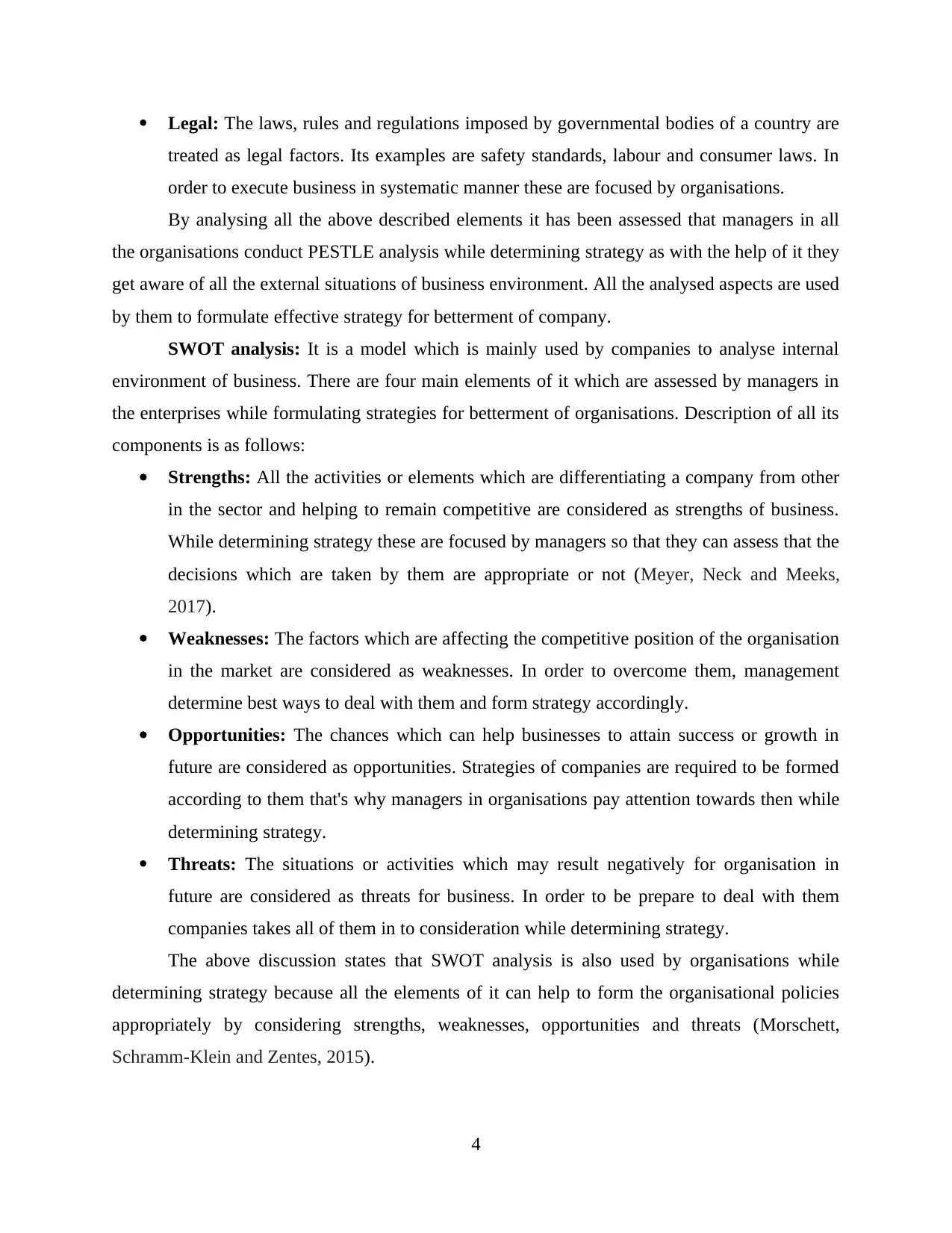
Legal: The laws, rules and regulations imposed by governmental bodies of a country are
treated as legal factors. Its examples are safety standards, labour and consumer laws. In
order to execute business in systematic manner these are focused by organisations.
By analysing all the above described elements it has been assessed that managers in all
the organisations conduct PESTLE analysis while determining strategy as with the help of it they
get aware of all the external situations of business environment. All the analysed aspects are used
by them to formulate effective strategy for betterment of company.
SWOT analysis: It is a model which is mainly used by companies to analyse internal
environment of business. There are four main elements of it which are assessed by managers in
the enterprises while formulating strategies for betterment of organisations. Description of all its
components is as follows:
Strengths: All the activities or elements which are differentiating a company from other
in the sector and helping to remain competitive are considered as strengths of business.
While determining strategy these are focused by managers so that they can assess that the
decisions which are taken by them are appropriate or not (Meyer, Neck and Meeks,
2017).
Weaknesses: The factors which are affecting the competitive position of the organisation
in the market are considered as weaknesses. In order to overcome them, management
determine best ways to deal with them and form strategy accordingly.
Opportunities: The chances which can help businesses to attain success or growth in
future are considered as opportunities. Strategies of companies are required to be formed
according to them that's why managers in organisations pay attention towards then while
determining strategy.
Threats: The situations or activities which may result negatively for organisation in
future are considered as threats for business. In order to be prepare to deal with them
companies takes all of them in to consideration while determining strategy.
The above discussion states that SWOT analysis is also used by organisations while
determining strategy because all the elements of it can help to form the organisational policies
appropriately by considering strengths, weaknesses, opportunities and threats (Morschett,
Schramm-Klein and Zentes, 2015).
4
treated as legal factors. Its examples are safety standards, labour and consumer laws. In
order to execute business in systematic manner these are focused by organisations.
By analysing all the above described elements it has been assessed that managers in all
the organisations conduct PESTLE analysis while determining strategy as with the help of it they
get aware of all the external situations of business environment. All the analysed aspects are used
by them to formulate effective strategy for betterment of company.
SWOT analysis: It is a model which is mainly used by companies to analyse internal
environment of business. There are four main elements of it which are assessed by managers in
the enterprises while formulating strategies for betterment of organisations. Description of all its
components is as follows:
Strengths: All the activities or elements which are differentiating a company from other
in the sector and helping to remain competitive are considered as strengths of business.
While determining strategy these are focused by managers so that they can assess that the
decisions which are taken by them are appropriate or not (Meyer, Neck and Meeks,
2017).
Weaknesses: The factors which are affecting the competitive position of the organisation
in the market are considered as weaknesses. In order to overcome them, management
determine best ways to deal with them and form strategy accordingly.
Opportunities: The chances which can help businesses to attain success or growth in
future are considered as opportunities. Strategies of companies are required to be formed
according to them that's why managers in organisations pay attention towards then while
determining strategy.
Threats: The situations or activities which may result negatively for organisation in
future are considered as threats for business. In order to be prepare to deal with them
companies takes all of them in to consideration while determining strategy.
The above discussion states that SWOT analysis is also used by organisations while
determining strategy because all the elements of it can help to form the organisational policies
appropriately by considering strengths, weaknesses, opportunities and threats (Morschett,
Schramm-Klein and Zentes, 2015).
4
⊘ This is a preview!⊘
Do you want full access?
Subscribe today to unlock all pages.

Trusted by 1+ million students worldwide
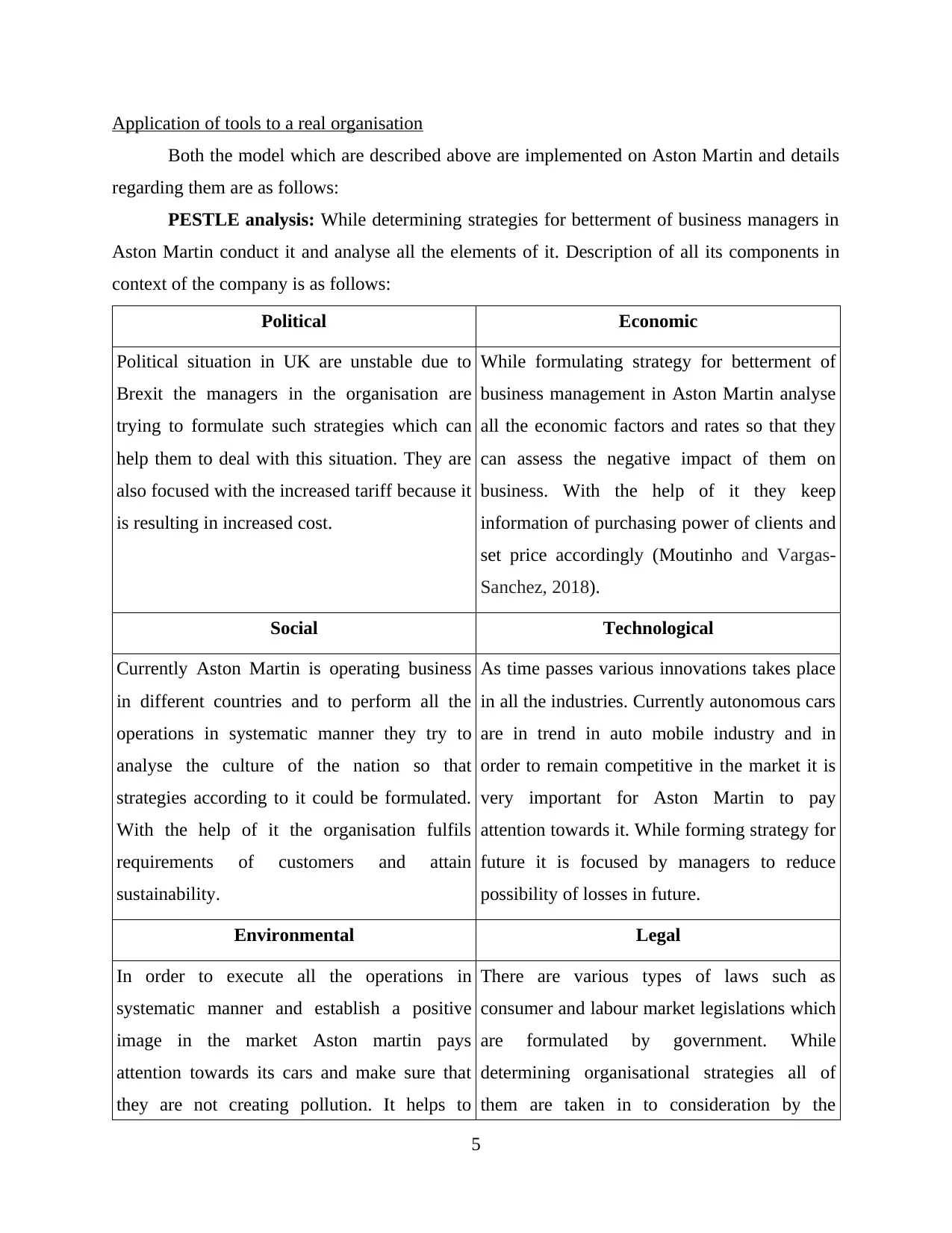
Application of tools to a real organisation
Both the model which are described above are implemented on Aston Martin and details
regarding them are as follows:
PESTLE analysis: While determining strategies for betterment of business managers in
Aston Martin conduct it and analyse all the elements of it. Description of all its components in
context of the company is as follows:
Political Economic
Political situation in UK are unstable due to
Brexit the managers in the organisation are
trying to formulate such strategies which can
help them to deal with this situation. They are
also focused with the increased tariff because it
is resulting in increased cost.
While formulating strategy for betterment of
business management in Aston Martin analyse
all the economic factors and rates so that they
can assess the negative impact of them on
business. With the help of it they keep
information of purchasing power of clients and
set price accordingly (Moutinho and Vargas-
Sanchez, 2018).
Social Technological
Currently Aston Martin is operating business
in different countries and to perform all the
operations in systematic manner they try to
analyse the culture of the nation so that
strategies according to it could be formulated.
With the help of it the organisation fulfils
requirements of customers and attain
sustainability.
As time passes various innovations takes place
in all the industries. Currently autonomous cars
are in trend in auto mobile industry and in
order to remain competitive in the market it is
very important for Aston Martin to pay
attention towards it. While forming strategy for
future it is focused by managers to reduce
possibility of losses in future.
Environmental Legal
In order to execute all the operations in
systematic manner and establish a positive
image in the market Aston martin pays
attention towards its cars and make sure that
they are not creating pollution. It helps to
There are various types of laws such as
consumer and labour market legislations which
are formulated by government. While
determining organisational strategies all of
them are taken in to consideration by the
5
Both the model which are described above are implemented on Aston Martin and details
regarding them are as follows:
PESTLE analysis: While determining strategies for betterment of business managers in
Aston Martin conduct it and analyse all the elements of it. Description of all its components in
context of the company is as follows:
Political Economic
Political situation in UK are unstable due to
Brexit the managers in the organisation are
trying to formulate such strategies which can
help them to deal with this situation. They are
also focused with the increased tariff because it
is resulting in increased cost.
While formulating strategy for betterment of
business management in Aston Martin analyse
all the economic factors and rates so that they
can assess the negative impact of them on
business. With the help of it they keep
information of purchasing power of clients and
set price accordingly (Moutinho and Vargas-
Sanchez, 2018).
Social Technological
Currently Aston Martin is operating business
in different countries and to perform all the
operations in systematic manner they try to
analyse the culture of the nation so that
strategies according to it could be formulated.
With the help of it the organisation fulfils
requirements of customers and attain
sustainability.
As time passes various innovations takes place
in all the industries. Currently autonomous cars
are in trend in auto mobile industry and in
order to remain competitive in the market it is
very important for Aston Martin to pay
attention towards it. While forming strategy for
future it is focused by managers to reduce
possibility of losses in future.
Environmental Legal
In order to execute all the operations in
systematic manner and establish a positive
image in the market Aston martin pays
attention towards its cars and make sure that
they are not creating pollution. It helps to
There are various types of laws such as
consumer and labour market legislations which
are formulated by government. While
determining organisational strategies all of
them are taken in to consideration by the
5
Paraphrase This Document
Need a fresh take? Get an instant paraphrase of this document with our AI Paraphraser
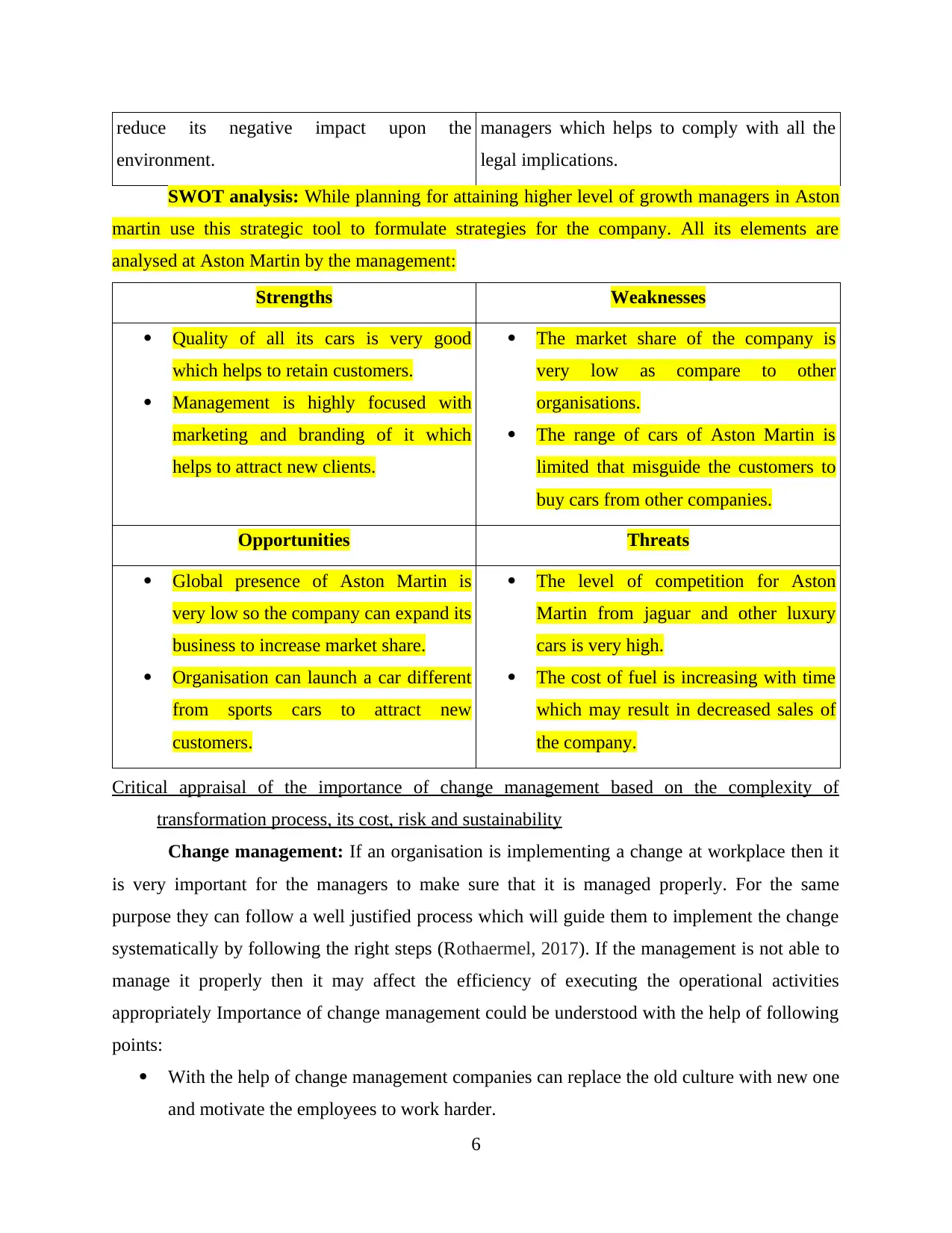
reduce its negative impact upon the
environment.
managers which helps to comply with all the
legal implications.
SWOT analysis: While planning for attaining higher level of growth managers in Aston
martin use this strategic tool to formulate strategies for the company. All its elements are
analysed at Aston Martin by the management:
Strengths Weaknesses
Quality of all its cars is very good
which helps to retain customers.
Management is highly focused with
marketing and branding of it which
helps to attract new clients.
The market share of the company is
very low as compare to other
organisations.
The range of cars of Aston Martin is
limited that misguide the customers to
buy cars from other companies.
Opportunities Threats
Global presence of Aston Martin is
very low so the company can expand its
business to increase market share.
Organisation can launch a car different
from sports cars to attract new
customers.
The level of competition for Aston
Martin from jaguar and other luxury
cars is very high.
The cost of fuel is increasing with time
which may result in decreased sales of
the company.
Critical appraisal of the importance of change management based on the complexity of
transformation process, its cost, risk and sustainability
Change management: If an organisation is implementing a change at workplace then it
is very important for the managers to make sure that it is managed properly. For the same
purpose they can follow a well justified process which will guide them to implement the change
systematically by following the right steps (Rothaermel, 2017). If the management is not able to
manage it properly then it may affect the efficiency of executing the operational activities
appropriately Importance of change management could be understood with the help of following
points:
With the help of change management companies can replace the old culture with new one
and motivate the employees to work harder.
6
environment.
managers which helps to comply with all the
legal implications.
SWOT analysis: While planning for attaining higher level of growth managers in Aston
martin use this strategic tool to formulate strategies for the company. All its elements are
analysed at Aston Martin by the management:
Strengths Weaknesses
Quality of all its cars is very good
which helps to retain customers.
Management is highly focused with
marketing and branding of it which
helps to attract new clients.
The market share of the company is
very low as compare to other
organisations.
The range of cars of Aston Martin is
limited that misguide the customers to
buy cars from other companies.
Opportunities Threats
Global presence of Aston Martin is
very low so the company can expand its
business to increase market share.
Organisation can launch a car different
from sports cars to attract new
customers.
The level of competition for Aston
Martin from jaguar and other luxury
cars is very high.
The cost of fuel is increasing with time
which may result in decreased sales of
the company.
Critical appraisal of the importance of change management based on the complexity of
transformation process, its cost, risk and sustainability
Change management: If an organisation is implementing a change at workplace then it
is very important for the managers to make sure that it is managed properly. For the same
purpose they can follow a well justified process which will guide them to implement the change
systematically by following the right steps (Rothaermel, 2017). If the management is not able to
manage it properly then it may affect the efficiency of executing the operational activities
appropriately Importance of change management could be understood with the help of following
points:
With the help of change management companies can replace the old culture with new one
and motivate the employees to work harder.
6
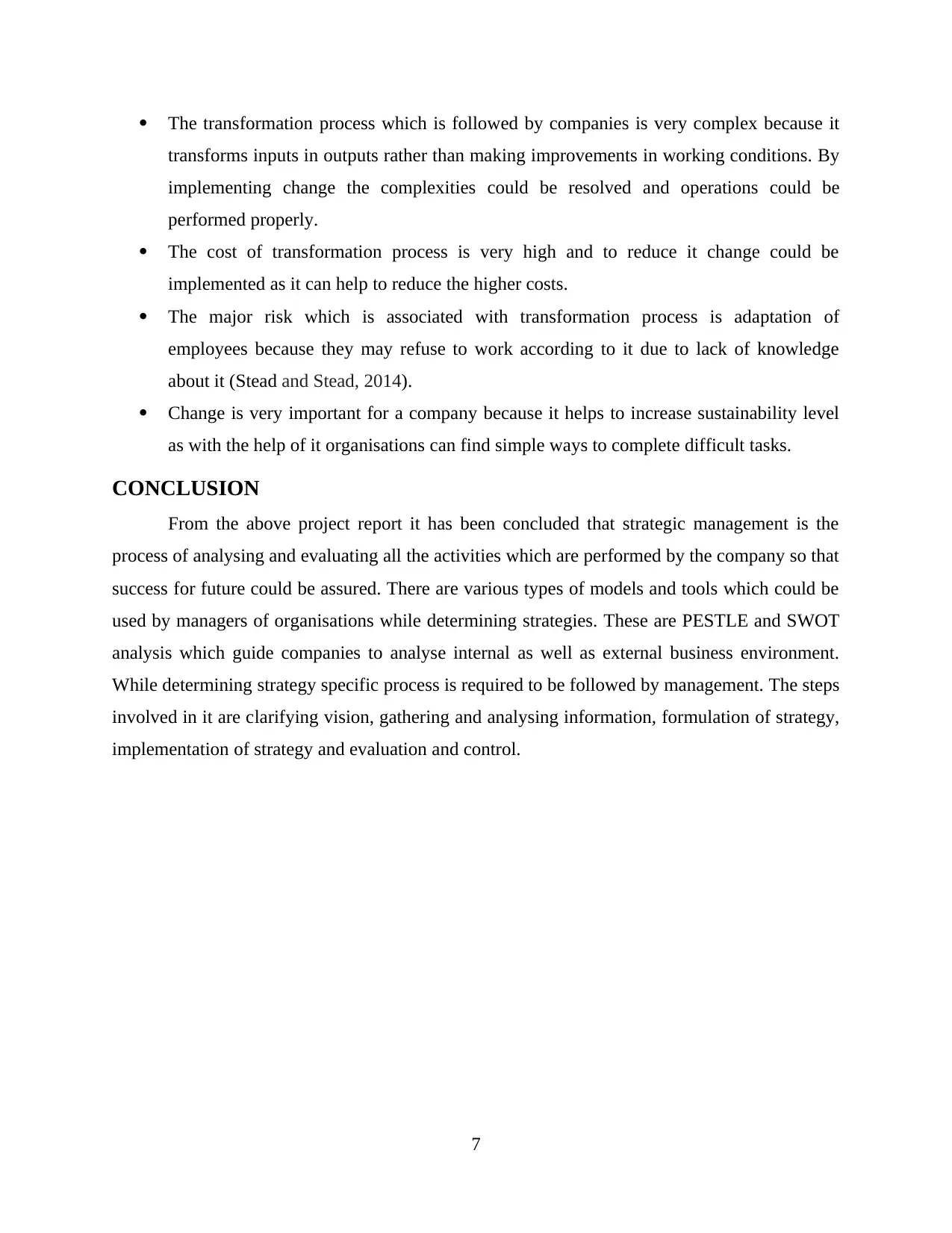
The transformation process which is followed by companies is very complex because it
transforms inputs in outputs rather than making improvements in working conditions. By
implementing change the complexities could be resolved and operations could be
performed properly.
The cost of transformation process is very high and to reduce it change could be
implemented as it can help to reduce the higher costs.
The major risk which is associated with transformation process is adaptation of
employees because they may refuse to work according to it due to lack of knowledge
about it (Stead and Stead, 2014).
Change is very important for a company because it helps to increase sustainability level
as with the help of it organisations can find simple ways to complete difficult tasks.
CONCLUSION
From the above project report it has been concluded that strategic management is the
process of analysing and evaluating all the activities which are performed by the company so that
success for future could be assured. There are various types of models and tools which could be
used by managers of organisations while determining strategies. These are PESTLE and SWOT
analysis which guide companies to analyse internal as well as external business environment.
While determining strategy specific process is required to be followed by management. The steps
involved in it are clarifying vision, gathering and analysing information, formulation of strategy,
implementation of strategy and evaluation and control.
7
transforms inputs in outputs rather than making improvements in working conditions. By
implementing change the complexities could be resolved and operations could be
performed properly.
The cost of transformation process is very high and to reduce it change could be
implemented as it can help to reduce the higher costs.
The major risk which is associated with transformation process is adaptation of
employees because they may refuse to work according to it due to lack of knowledge
about it (Stead and Stead, 2014).
Change is very important for a company because it helps to increase sustainability level
as with the help of it organisations can find simple ways to complete difficult tasks.
CONCLUSION
From the above project report it has been concluded that strategic management is the
process of analysing and evaluating all the activities which are performed by the company so that
success for future could be assured. There are various types of models and tools which could be
used by managers of organisations while determining strategies. These are PESTLE and SWOT
analysis which guide companies to analyse internal as well as external business environment.
While determining strategy specific process is required to be followed by management. The steps
involved in it are clarifying vision, gathering and analysing information, formulation of strategy,
implementation of strategy and evaluation and control.
7
⊘ This is a preview!⊘
Do you want full access?
Subscribe today to unlock all pages.

Trusted by 1+ million students worldwide
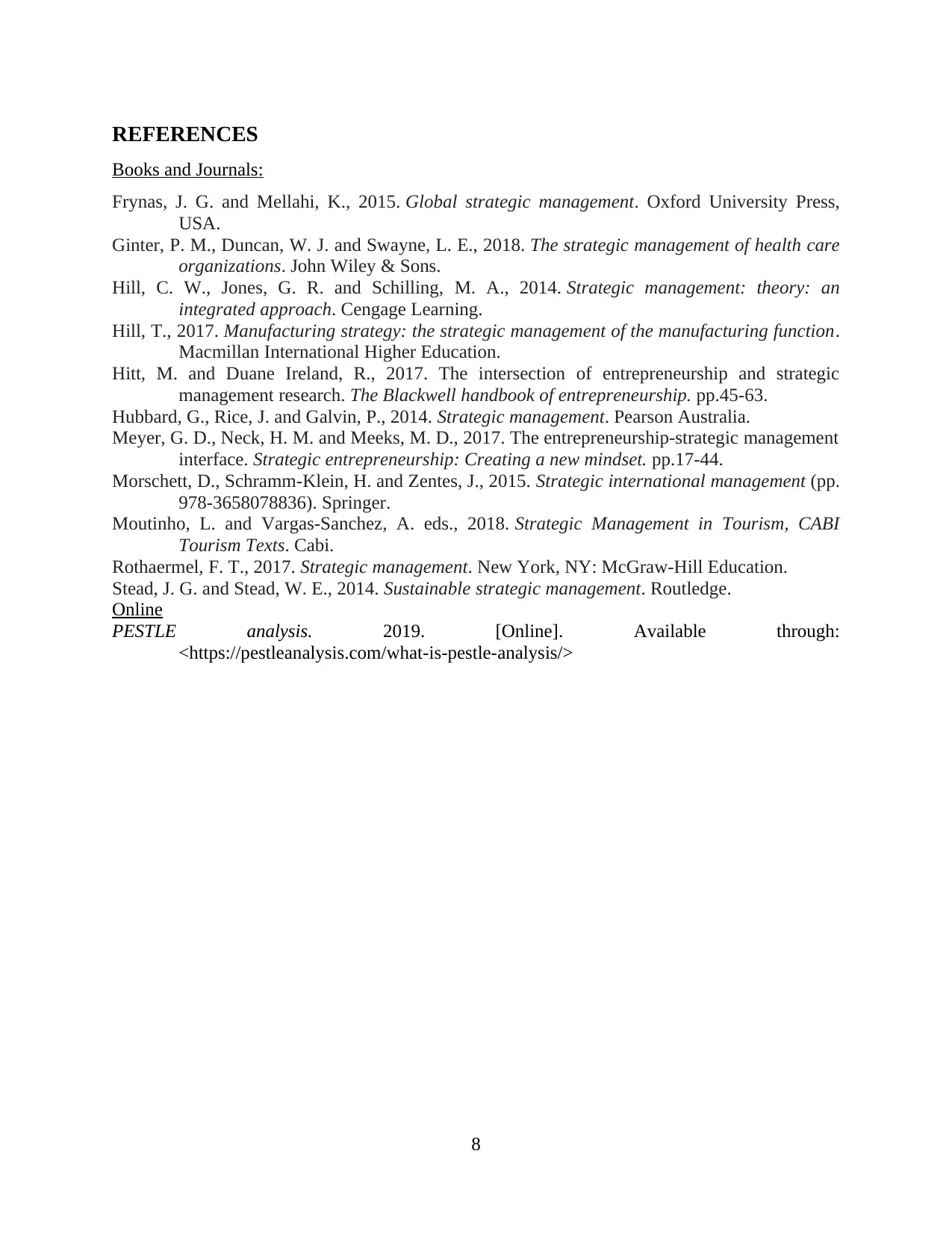
REFERENCES
Books and Journals:
Frynas, J. G. and Mellahi, K., 2015. Global strategic management. Oxford University Press,
USA.
Ginter, P. M., Duncan, W. J. and Swayne, L. E., 2018. The strategic management of health care
organizations. John Wiley & Sons.
Hill, C. W., Jones, G. R. and Schilling, M. A., 2014. Strategic management: theory: an
integrated approach. Cengage Learning.
Hill, T., 2017. Manufacturing strategy: the strategic management of the manufacturing function.
Macmillan International Higher Education.
Hitt, M. and Duane Ireland, R., 2017. The intersection of entrepreneurship and strategic
management research. The Blackwell handbook of entrepreneurship. pp.45-63.
Hubbard, G., Rice, J. and Galvin, P., 2014. Strategic management. Pearson Australia.
Meyer, G. D., Neck, H. M. and Meeks, M. D., 2017. The entrepreneurship‐strategic management
interface. Strategic entrepreneurship: Creating a new mindset. pp.17-44.
Morschett, D., Schramm-Klein, H. and Zentes, J., 2015. Strategic international management (pp.
978-3658078836). Springer.
Moutinho, L. and Vargas-Sanchez, A. eds., 2018. Strategic Management in Tourism, CABI
Tourism Texts. Cabi.
Rothaermel, F. T., 2017. Strategic management. New York, NY: McGraw-Hill Education.
Stead, J. G. and Stead, W. E., 2014. Sustainable strategic management. Routledge.
Online
PESTLE analysis. 2019. [Online]. Available through:
<https://pestleanalysis.com/what-is-pestle-analysis/>
8
Books and Journals:
Frynas, J. G. and Mellahi, K., 2015. Global strategic management. Oxford University Press,
USA.
Ginter, P. M., Duncan, W. J. and Swayne, L. E., 2018. The strategic management of health care
organizations. John Wiley & Sons.
Hill, C. W., Jones, G. R. and Schilling, M. A., 2014. Strategic management: theory: an
integrated approach. Cengage Learning.
Hill, T., 2017. Manufacturing strategy: the strategic management of the manufacturing function.
Macmillan International Higher Education.
Hitt, M. and Duane Ireland, R., 2017. The intersection of entrepreneurship and strategic
management research. The Blackwell handbook of entrepreneurship. pp.45-63.
Hubbard, G., Rice, J. and Galvin, P., 2014. Strategic management. Pearson Australia.
Meyer, G. D., Neck, H. M. and Meeks, M. D., 2017. The entrepreneurship‐strategic management
interface. Strategic entrepreneurship: Creating a new mindset. pp.17-44.
Morschett, D., Schramm-Klein, H. and Zentes, J., 2015. Strategic international management (pp.
978-3658078836). Springer.
Moutinho, L. and Vargas-Sanchez, A. eds., 2018. Strategic Management in Tourism, CABI
Tourism Texts. Cabi.
Rothaermel, F. T., 2017. Strategic management. New York, NY: McGraw-Hill Education.
Stead, J. G. and Stead, W. E., 2014. Sustainable strategic management. Routledge.
Online
PESTLE analysis. 2019. [Online]. Available through:
<https://pestleanalysis.com/what-is-pestle-analysis/>
8
1 out of 10
Related Documents
Your All-in-One AI-Powered Toolkit for Academic Success.
+13062052269
info@desklib.com
Available 24*7 on WhatsApp / Email
![[object Object]](/_next/static/media/star-bottom.7253800d.svg)
Unlock your academic potential
Copyright © 2020–2025 A2Z Services. All Rights Reserved. Developed and managed by ZUCOL.





